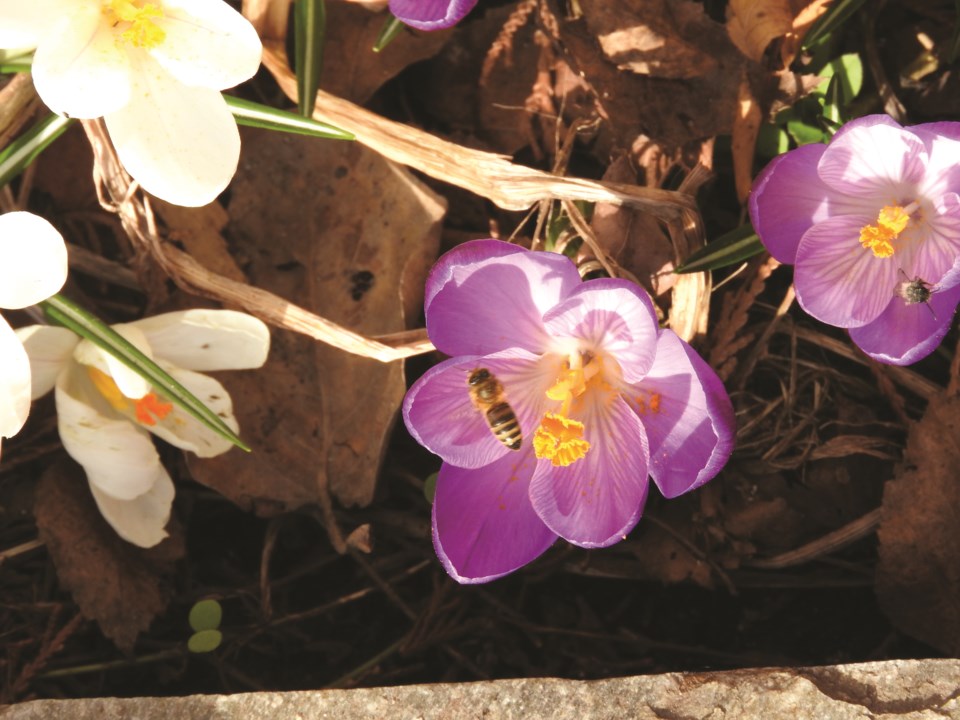An old beekeeper interviewed on CBC Radio ages ago shared a secret I’ll never forget: He eats a teaspoon of honey every night before bedtime. Rocket fuel for the brain, he explained. Rocket fuel to keep those neurons firing all night long.
Delores Franz Los has a honey secret, too. She’s got loads of them, actually, but this is a favourite: “People say if you eat a teaspoon of honey a day, you’ll never get a cold,” she says. She does (eat a teaspoon a day) and she never does (get a cold). Imagine how healthy the beekeeper is who lives on the Greek Island of Ikaria and reports that he eats a kilo of honey a week!
Delores, in case you didn’t meet her in Alyssa Noel’s great article in Pique, April 8, has set up something wonderful—a community beehive project in Pemberton so anyone, especially kids, can get up close and personal with bees. Given she’s kept bees for more than four decades (she first moved to the Sea to Sky in 1977), she’s also pretty much a honey expert in my books.
Powerful, good for you, and embedded in our cultural lexicon since ancient times—the Greek term for golden strands of dripping honey also means “paradise”—you can’t go wrong with a jar of good honey in your cupboard. The key is the word “good” and that means knowing where your honey comes from and how to keep it properly.
“Just be careful which honey you buy so you don’t get corn syrup or rice syrup in it—but you just get real honey,” Delores cautions. I bet you’ve heard that in the news, too: Stories of honey adulterated with corn syrup, glucose syrup, you name it—anything cheaper to produce than the real thing.
Thankfully, Canada has strong standards for ensuring honey produced here is 100-per-cent genuine. In fact, Delores’ honey has been used to develop testing protocols for honey purity. But that isn’t the case around the world. Even the U.S. has pretty lax regulations. To top things off, you don’t know how carefully processors have handled it, so buyer beware.
Your best source is a reliable beekeeper and, yes, Delores does sell some of the 400 pounds of honey her hives in Pemberton Valley produce annually. But, sorry, she has no capacity for new customers, so ask around wherever you live for a reliable producer. There are dozens from Lillooet on down through the Fraser Valley, plus check out your local farmers’ market when it’s up and running. Squamish Climate Action Network and Pemberton Farmers’ Institute are also good resources.
Once you get your good, reliably produced honey home, take good care of it. Real honey will crystallize over time. To liquify it, just set it in a pan of warm water. Never boil or microwave it, warns Delores. And if you need to store it a while, simply pop it in the freezer to keep it fresh, like she does, then let it warm up at room temperature.
BEES LOVE IT WHEN YOU MESS UP
Honey is so amazing, if I could, I’d personally thank each and every one of the 50,000 to 80,000 honeybees in a hive that make it and pollinate our crops and wildflowers at the same time.
Honeybees aren’t native to B.C. but hundreds of wild bee species are, and at one time harvesting wild honey was the only way to go. It’s a dying art now, which was why it was so exciting to see Hatidže Muratova of Macedonia harvesting beautiful wild honey in the award-winning documentary Honeyland I described last column. Her neighbours, on the other hand, brought in too many hives, which drove away the wild bees.
You might not believe it, but thanks to our huge variety of ecosystems, we have 450 to 500 species of wild bees in B.C. alone! Unfortunately, dozens of species are endangered due to the climate emergency and other human interference. So good organizations like the Master Gardeners Association of B.C., UBC’s BeeHIVE Research Cluster and the Native Bee Society of B.C. are trying to reverse the trend.
Most wild bees fly for only two to four weeks, depending on the species, the weather and the availability of forage. Unlike honeybees, which Delores says travel up to 12 kilometres in search of nectar and pollen, wild bees don’t fly far—the length of a football field, max.
That’s where we humans can lend a hand. Adding wildflowers bees love to your garden and lawn is a great first step. East Van Bees, for one, makes it easy with their wildflower pollinator bee blend. (They also run a “host a hive” program you can join, and sell beeswax food wraps like Pemberton’s young activist, Sam Tierney, is a fan of.)
As for lawns, join the craze and stop mowing it! Think of the time and energy you’ll save on all levels by letting those dandelions bloom. Even local park managers are finally following a popular strategy in Europe—only mowing small areas in parks, allowing the rest to go “au natural” for bees and their buddies.
Let your hair down and your yard get messy. Stop raking up those leaves! Seventy per cent of B.C.’s hundreds of wild bee species nest in the ground in tunnels, and often struggle to find a safe place to lay their eggs. Messy gardens and lawns provide the hollow stalks and leaves they need. These bees also use mud, so leave out water to help them make their own.
Happy bee helping! I’m off for a teaspoon of rocket fuel now.
Glenda Bartosh is an award-winning journalist who keeps two sources of clean water outside year-round, one on the ground.




